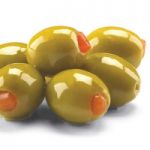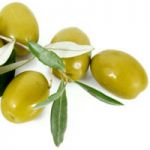 |
French: Olive d'Espagne
Did you know that 50% of European olives come from Spain ? With its rich and varied history it’s not surprising that Spain offers an estimated 260 different varieties of olive, from the shimmering olive groves that spread over a considerable sweep the country. While many of these varieties are grown for olive oil there is still a huge selection grown for the table, to be enjoyed as plain black or green olives or stuffed with a variety of tasty fillings as part of a tapas selection.
He re are the most leading types of Spanish table Olives (Aceitunas):

Manzanillas are the most popular Spanish olives, and these are the highest quality available. Handpicked in Andalusia, pitted, and packed in an artisanal quality brine, the olives are naturally fermented and cured Sevillian style. The name manzanilla, meaning “little apple” in Spanish, comes from the olives shape. While you’ll find a variety of table olives served throughout Spain, this variety is the most ubiquitous, thanks in part to the high volume taken from each tree, and in part to the crisp, nutty flavor.

Also known as queen olives or colossal olives, these are larger than manzanillas. Loved for its fleshy pulp and large size, it’s no wonder that Gordal means “the fat one.” Also referred to as “the beauty of Spain,” this green olive, characterized by its oval and slightly asymmetric shape, is one of the world’s best-known olives. With its low oil content, the Gordal is never used in olive oil production. Instead, it’s commonly served as a table olive, as most people find its fleshy texture and delicate flavour irresistible!

The name comes from the whitish (blanca) underside of the leaves, which gives the tree a silvery appearance from a distance. You may remember seeing this attractive tree if your travels found you east of Sevilla, south of Córdoba and across the north of Málaga. The fruit is usually large, plump and almost perfectly spherical. Hojiblanca is served as a black table olive because of the firm texture of its flesh.
Hojiblanca has a tremendous range of flavors, but the most characteristic one is sweetness when first tasted, followed by a slightly bitter almond aftertaste.

-

 Recipes
Recipes
-

 Products
Products
-

 Entertaining
Entertaining
-

 Chefs
Chefs
-

 Hints & Tips
Hints & Tips
-

 Glossaries
Glossaries








